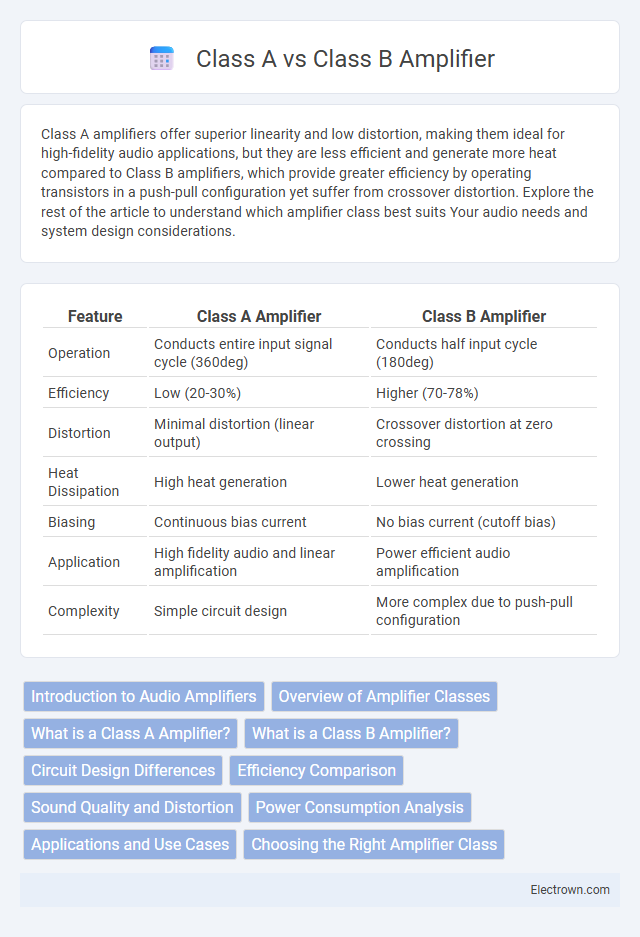Class A amplifiers offer superior linearity and low distortion, making them ideal for high-fidelity audio applications, but they are less efficient and generate more heat compared to Class B amplifiers, which provide greater efficiency by operating transistors in a push-pull configuration yet suffer from crossover distortion. Explore the rest of the article to understand which amplifier class best suits Your audio needs and system design considerations.
Table of Comparison
| Feature | Class A Amplifier | Class B Amplifier |
|---|---|---|
| Operation | Conducts entire input signal cycle (360deg) | Conducts half input cycle (180deg) |
| Efficiency | Low (20-30%) | Higher (70-78%) |
| Distortion | Minimal distortion (linear output) | Crossover distortion at zero crossing |
| Heat Dissipation | High heat generation | Lower heat generation |
| Biasing | Continuous bias current | No bias current (cutoff bias) |
| Application | High fidelity audio and linear amplification | Power efficient audio amplification |
| Complexity | Simple circuit design | More complex due to push-pull configuration |
Introduction to Audio Amplifiers
Class A and Class B audio amplifiers differ primarily in their operation and efficiency, affecting sound quality and power usage. Class A amplifiers conduct current continuously, producing high-fidelity audio with low distortion but generating more heat and consuming more power. Class B amplifiers, designed to be more efficient, use two transistors that conduct alternately, reducing power consumption but sometimes introducing crossover distortion into your audio.
Overview of Amplifier Classes
Class A amplifiers operate with their output transistors conducting throughout the entire input signal cycle, delivering high linearity and low distortion at the expense of efficiency, typically around 20-30%. Class B amplifiers conduct only during half of the input signal cycle, significantly improving efficiency to about 50-70% but introducing crossover distortion at the signal's zero crossing. Choosing between Class A and Class B depends on your priority for either audio fidelity or power efficiency in amplification applications.
What is a Class A Amplifier?
A Class A amplifier operates with its output transistor conducting continuously throughout the entire input signal cycle, ensuring high linearity and low distortion. This design generates significant heat due to constant current flow, often requiring robust heat dissipation methods. Understanding how your audio system benefits from a Class A amplifier can help you achieve superior sound quality with minimal signal degradation.
What is a Class B Amplifier?
A Class B amplifier operates by driving each half of the output waveform with separate transistors, conducting only during one half-cycle of the input signal. This approach reduces power dissipation and increases efficiency compared to Class A amplifiers, as transistors are off for half of the signal cycle, minimizing heat generation. However, Class B amplifiers can introduce crossover distortion at the point where the output switches between transistors, which may affect sound quality in audio applications.
Circuit Design Differences
Class A amplifiers operate with the output transistor conducting continuously over the entire input signal cycle, resulting in simpler circuit design characterized by a single transistor or push-pull configuration with high quiescent current and linear operation. Class B amplifiers use a pair of transistors, each conducting for half of the input signal cycle, implementing a push-pull circuit design that improves efficiency by reducing quiescent current but introduces crossover distortion. The design differences hinge on biasing methods and transistor operation intervals, with Class A emphasizing linearity and Class B focusing on efficiency and power savings.
Efficiency Comparison
Class A amplifiers exhibit low efficiency, typically around 20-30%, due to their continuous operation in the linear region, resulting in significant power dissipation as heat. Class B amplifiers improve efficiency substantially, often reaching 70-78%, by conducting current only during half of the input signal cycle and reducing power loss. The efficiency difference is crucial in applications where power consumption and heat management are critical factors.
Sound Quality and Distortion
Class A amplifiers deliver superior sound quality with minimal distortion due to their continuous conduction of output devices, ensuring a linear and precise audio signal. Class B amplifiers, while more efficient, tend to produce crossover distortion as the output devices switch on and off during signal transitions, compromising sound fidelity. Your choice between Class A and Class B affects audio clarity significantly, with Class A favored for high-fidelity applications and Class B for power-efficient uses.
Power Consumption Analysis
Class A amplifiers exhibit continuous conduction of output transistors, resulting in high power consumption and low efficiency, often below 30%, as they dissipate significant power as heat even without input signal. Class B amplifiers operate with output transistors conducting alternately for each half-cycle of the input signal, achieving higher efficiency, typically around 70%, by minimizing idle power loss. The power consumption difference makes Class B amplifiers more suitable for energy-sensitive applications, while Class A amplifiers are favored for their linearity and low distortion despite greater power use.
Applications and Use Cases
Class A amplifiers offer high-fidelity audio output ideal for professional audio equipment and high-end headphone amplifiers where sound quality is paramount. Class B amplifiers are suited for battery-powered devices and portable audio systems due to their higher efficiency and lower power consumption. Your choice depends on whether you prioritize audio precision or energy efficiency in applications like home theaters, radio transmitters, or PA systems.
Choosing the Right Amplifier Class
Choosing the right amplifier class depends on your priorities between audio quality and energy efficiency. Class A amplifiers deliver superior sound fidelity with minimal distortion but consume more power and generate heat, making them ideal for audiophiles. Class B amplifiers offer higher efficiency by using complementary transistor pairs but may introduce crossover distortion, so your choice hinges on whether you prioritize pristine audio performance or practical power management.
Class A vs Class B amplifier Infographic

 electrown.com
electrown.com